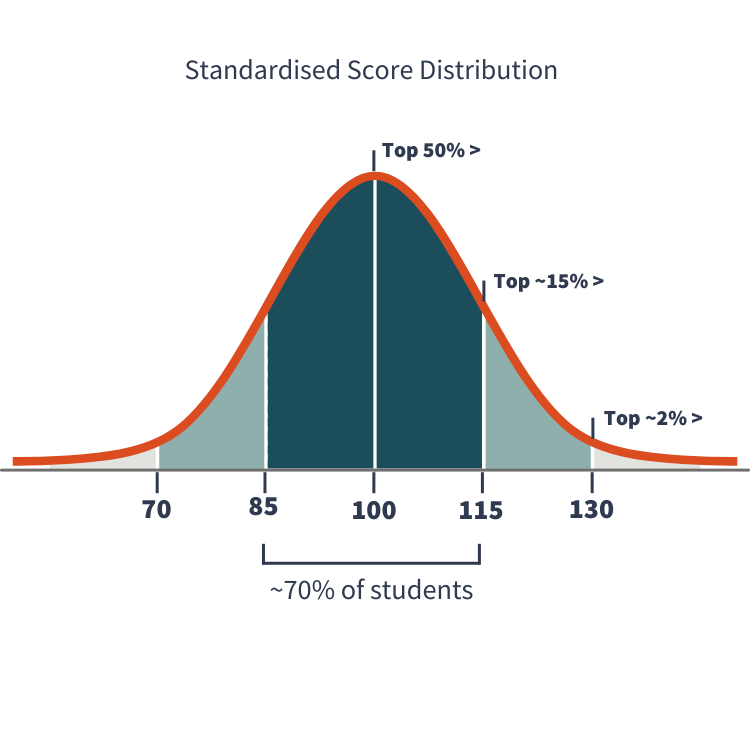Expert Insights
11 Plus Standardised Scores Explained
Published 20th July 2024 by Alastair

Understanding the scoring system for the 11+ can be confusing, especially if you are unfamiliar with the exam format.
For parents, getting to grips with the 11+ standardised scoring system can help gauge their child's performance in preparing for competitive 11+ Grammar & Independent schools, where every mark counts. A better understanding of the system can help you identify your child's performance in relation to the target school they're applying to and how well they performed against their peers.
We've asked our 11+ admissions team to clarify the process to help you understand how some surprising factors, such as their month of birth, count towards your child's final results so you can effectively calculate how their raw mark gets converted to a final score.
P.S. Need 11+ Support?
We provide bespoke, expert tuition and educational advice for 11+ admissions, helping students gain entry to leading UK schools.
Click here to submit an enquiry.
Now on to the rest of the article...
The point of standardising scores for the 11 Plus exam is to adjust for variable factors to ensure fairness among students of differing ages and across different test paper weightings.
For example, additional marks are awarded to younger students to offset age-related advantages, and scores are averaged out to ensure the difficulty is standardised year-on-year. After combining these different variables, the "raw score" is converted into a standardised score, typically between 70 and 140.
The Test
Every test paper is created differently, with a different total score and weighting distribution that can vary considerably. For example, in an English paper, a test can have 40 total marks in one year and 45 marks in the next. This would be true for all four subjects. A typical 11+ paper could consist of 75 marks for Maths, 45 for Verbal Reasoning, 50 for Non-Verbal Reasoning, and 60 for English. The timing of each paper can also vary, depending on the amount of marks.
Standardising the test is, therefore, a way to value each test's results equally, regardless of the total questions and the time designated.
The Child
As there can be a significant difference in performance between children born at the beginning vs the end of a school year, a method is needed to account for younger students who may find a test harder than their peers within the same year group. A child born on September 1st will have a whole year's advantage over a child born on the last day of the school year. To remove this disparity, marks are standardised for all children, regardless of age.
Take the example of the two children above:
Child A, born on September 1st, scores 76/85 on their maths test. Child B gets the same result but was born on the 31st of August, a whole year (minus one day) later. While the "raw scores" achieved are the same, the younger student will be awarded extra marks, but the older children's marks will remain the same but are never deducted. In this scenario, child A could have an adjusted score of 122 and Child B an adjusted score of 125. So, while the score difference will likely only be by a couple of marks, it could be enough to be the difference between a place at your child's target school.
While this may seem unfair if your child is older, standardising scores is designed to make the test more fair, giving all children an equal playing field.
The exam boards creating the test papers may apply statistical data analysis to find the mean score based on a sample of children taking the test, either nationally or in the local area where the specific test is taking place. The results can also be compared to previous years, and the score is adjusted to the cohort, depending on whether the average score received is significantly more or less than the prior year’s paper. Another factor, as you could probably guess, is the age distribution of the entire cohort.
This information establishes a standardised score, with 100 as the average. The lowest adjusted scores will fall at around 70, and the highest will fall at around 140. Most students will fall somewhere in the middle, and it becomes increasingly rare for a child to fall at either end of the spectrum, creating a typical bell curve. While pass marks vary from school to school, they typically fall at around 115 and above for the most selective schools. We have provided a graph to provide more clarity to the standardised score below:

Use the table below and the graph above to help you see how this would work in real life. Please note that this is just an example table and each test will have a slightly different scoring sheet:
| Raw Score | 10Y0M | 10Y1M | 10Y2M | 10Y3M | 10Y4M | 10Y5M | 10Y6M | 10Y7M | 10Y8M | 10Y9M | 10Y10M | 10Y11M |
|---|---|---|---|---|---|---|---|---|---|---|---|---|
| 100 | 130 | 129 | 128 | 127 | 126 | 125 | 124 | 123 | 122 | 121 | 120 | 119 |
| 95 | 125 | 124 | 123 | 122 | 121 | 120 | 119 | 118 | 117 | 116 | 115 | 114 |
| 90 | 120 | 119 | 118 | 117 | 116 | 115 | 114 | 113 | 112 | 111 | 110 | 109 |
| 85 | 115 | 114 | 113 | 112 | 111 | 110 | 109 | 108 | 107 | 106 | 105 | 104 |
| 80 | 110 | 109 | 108 | 107 | 106 | 105 | 104 | 103 | 102 | 101 | 100 | 99 |
| 75 | 105 | 104 | 103 | 102 | 101 | 100 | 99 | 98 | 97 | 96 | 95 | 94 |
| 70 | 100 | 99 | 98 | 97 | 96 | 95 | 94 | 93 | 92 | 91 | 90 | 89 |
| 65 | 95 | 94 | 93 | 92 | 91 | 90 | 89 | 88 | 87 | 86 | 85 | 84 |
| 60 | 90 | 89 | 88 | 87 | 86 | 85 | 84 | 83 | 82 | 81 | 80 | 79 |
| 55 | 85 | 84 | 83 | 82 | 81 | 80 | 79 | 78 | 77 | 76 | 75 | 74 |
| 50 | 80 | 79 | 78 | 77 | 76 | 75 | 74 | 73 | 72 | 71 | 70 | 69 |
In the example above, a child born in October (10Y10M) receiving a score of ~85 would have their score adjusted to 105, falling somewhere in the middle of the bell curve for that particular test, performing better than just over ~63% of students taking the test.
Of course, as mentioned earlier, the standardised score table will differ from test to test, so only use this as a rough reference guide.
Different independent schools and grammar schools have their own rules and criteria for passing. Here are some examples for grammar schools, but remember that these numbers can change from year to year and can be different in different parts of the same region:
London: You usually need at least 80% to pass.
Kent: The pass score is typically around 330 out of 420, but it can change depending on how many students are taking the test that year.
Buckinghamshire: They often set a pass score of around 121 to 124.
Essex: You need a score of at least 303 to pass.
Birmingham: The pass score is around 220 out of 282 for both parts of the test.
Lincolnshire: Lincolnshire sets the pass mark at approximately 220 out of 282 (for both papers) for its selective schools.
These are just a few examples, and pass scores can be different in other places. Parents and students need to look into the specific requirements for the schools they want to get into and keep up with any changes. You can usually find this information on local authority websites or in school admission guides. It helps you understand what's expected for the 11 Plus exam in your area.
For independent schools, it is better to consider the CAT4 score your child is currently getting. For example, a student who is aiming for Westminster or St Paul’s Girls’ School should be scoring more than 135 in their CAT4. This is because these are some of the most competitive schools in the UK.

Just because your child is younger or older than their cohorts, it does not mean they will have any advantage or disadvantage. Therefore, you will have to look at your child's performance to ensure they do their best. Here are some important factors to consider:
The time of day the test is taken: Some students perform better in the morning when they are more alert, while others may peak later in the day. While this isn't something you can avoid, you can help offset this factor by ensuring your child gets enough sleep, is happy and healthy, and is prepared for the day.
Test anxiety and stress: High levels of anxiety can negatively impact performance, causing students to underperform relative to their actual ability. Don't put too much pressure on your child to perform well. Instead, give them encouragement and help them approach their preparation with a positive attitude. Taking mock exams, and utilising practice papers will help them feel more confident on the day.
Exam conditions: The test environment, seating arrangements, and noise levels can influence student concentration and performance. Again, mock exams and simulating exam environments at home can help your child familiarise themselves with the exam format.
Health and wellbeing: Physical and mental health on test day can significantly affect a student's ability to perform well. Ensure your child gets plenty of sleep, eats well, and remains physically active. All three of these play a significant role in your child's performance.
Test format familiarity: Familiarity with the test format helps reduce surprises, allowing students to focus on answering questions accurately. Ivy Education offers 11+ Practice Papers, which can help your child identify strengths and weaknesses in each exam format (English, Maths, Verbal and Non-Verbal Reasoning), and improve over time with our difficulty-tiered papers.
Time management skills: Effective time management enables students to allocate appropriate time to each section, reducing the risk of unanswered questions.
If your child needs any help with 11+ preparation, we offer 11+ Tuition, and exam papers to help them prepare thoroughly for their 11+ exams.
If you would like help with understanding your child's own standardised score, then look no further than Ivy Education's Academic Aptitude Test.
The aptitude tests offered by Ivy Education provide standardised scores that give a clear and objective measure of a student's academic abilities across key areas such as mathematics, verbal reasoning, non-verbal reasoning, and English proficiency. These scores are benchmarked against national and international standards, offering valuable insights into how a student’s performance compares to their peers. This enables families to make well-informed decisions about school applications and tailor their child’s preparation strategy to enhance their readiness for competitive admissions processes.
Understanding and utilising standardised scores can give you the upper hand in 11+ exam preparation. If you would like further support from our admissions experts, contact us today.
Check out our Exam Papers. We provide expertly crafted papers with tiered difficulty, allowing your child to progress at their own pace!
Explore Our Exam Papers 8.0 Top11 Plus standardised scores are adjusted marks that compare a child's performance to others sitting the same exam, accounting for variations in age and difficulty.
These scores are calculated by converting raw scores into a standard scale, typically considering the candidate's age and the average performance of all test-takers.
Standardisation ensures fairness, allowing younger children to compete on an equal footing with older peers, and provides a consistent measure across different test versions.
Age adjustments account for the exact age of each student, with younger candidates receiving a slight boost in their standardised score to level the playing field.
The scores generally range from 69 to 141, with 100 representing the average score.
A score of 115 or above is typically considered strong, indicating above-average performance and increasing chances of selection for competitive schools.
The highest possible score on the 11 Plus exam is usually 141.
It is usually around 80%, but varies from year to year, and school to school. The pass mark for the previous school year can often be found on the school's website.
The table maps raw scores to standardised scores, factoring in age adjustments and average scores to provide a fair comparison.
We're glad you asked! Ivy Education offers expert 11+ tuition, entrance exam preparation, and school advice. Contact us today for more information.















